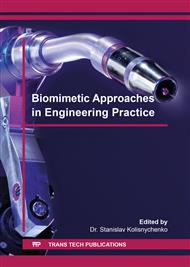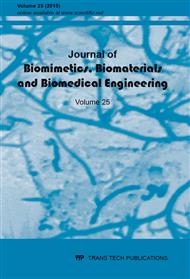[1]
Wu X, Cui P. The application of the bionic conception the new urban water front district design. Journal of Northwest University: Natural Science Edition, 2011, 41(2), pp.343-346.
Google Scholar
[2]
Hu N, Feng P, Dai G L. The gift from nature: bio-inspired strategy for developing innovative bridges. Journal of Bionic Engineering, 2013, 10(4), pp.405-414.
DOI: 10.1016/s1672-6529(13)60246-2
Google Scholar
[3]
Sun J R, Dai Z D. Bionics today and tomorrow. Acta Biophysica Sinica, 2007, 23(2), pp.109-115.
Google Scholar
[4]
Sun Y. Several new progresses of the researches on the bionics. Sci-Tech Information Development & Economy, 2006, 16(11), pp.143-144.
Google Scholar
[5]
Cheng W, Lin X Z, Wei X. Research progress in structure bionic materials. Materials Review, 2009, 23(S1), pp.399-403.
Google Scholar
[6]
He C L, Chen J X, Wu Z S, Xie J, Zu Q, Lu Y. Simulated effect on the compressive and shear mechanical properties of bionic integrated honeycomb plates. Materials Science and Engineering: C, 2015, 50, pp.286-293.
DOI: 10.1016/j.msec.2015.02.011
Google Scholar
[7]
Chen J X, Xie J, Zhu H, Guan S J, Wu G, Noori M N, Guo S J. Integrated honeycomb structure of a beetle forewing and its imitation. Materials Science and Engineering: C, 2012, 32(3), pp.613-618.
DOI: 10.1016/j.msec.2011.12.020
Google Scholar
[8]
Li B T, Hong J, Liu Z F. Stiffness design of machine tool structures by a biologically inspired topology optimization method. International Journal of Machine Tools and Manufacture, 2014, 84, pp.33-44.
DOI: 10.1016/j.ijmachtools.2014.03.005
Google Scholar
[9]
Zhong J, Meng J, Gui X C, Hu T, Xie N, Lu X Y, Yang Z Y, Koratkar N. Nanocarbon aerogel complexes inspired by the leaf structure. Carbon, 2014, 77, pp.637-644.
DOI: 10.1016/j.carbon.2014.05.068
Google Scholar
[10]
Wu X D, Ma S G. CPG-based control of serpentine locomotion of a snake-like robot. Mechatronics, 2010, 20(2), pp.326-334.
DOI: 10.1016/j.mechatronics.2010.01.006
Google Scholar
[11]
Song T L, Ling Z, Shen X X. The Research on remote control robot snake driving by servo. Procedia Engineering, 2011, 15, pp.762-766.
DOI: 10.1016/j.proeng.2011.08.142
Google Scholar
[12]
Ye Q H, Tao J, Yu D L, Li Z X. A survey of bionic design in spatial structures. Structural Engineer, 2010, 26(3), pp.13-18.
Google Scholar
[13]
Ishiguro H. Android science: conscious and subconscious recognition. Connection Science, 2006, 18(4), pp.319-332.
DOI: 10.1080/09540090600873953
Google Scholar
[14]
Chen X, Wang L Q, Ye X F, Wang G, Wang H L. Prototype development and gait planning of biologically inspired multi-legged crablike robot. Mechatronics, 2013, 23(4), pp.429-444.
DOI: 10.1016/j.mechatronics.2013.03.006
Google Scholar
[15]
Li F, Liu W T, Fu X, Bonsignori G, Scarfogliero U, Stefanini C, Dario P. Jumping like an insect: design and dynamic optimization of a jumping mini robot based on bio-mimetic inspiration. Mechatronics, 2012, 22(2), pp.167-176.
DOI: 10.1016/j.mechatronics.2012.01.001
Google Scholar
[16]
Xue X, Liu J. Mechanism interpretation of the biological brain cooling and its inspiration on bionic engineering. Journal of Bionic Engineering, 2011, 8(3), pp.207-222.
DOI: 10.1016/s1672-6529(11)60030-9
Google Scholar
[17]
Zhang Q, Dai Q X, Zhao Y T , Cheng X N. Progress in design and fabrication of biomimetic material. Journal of Jiangsu University: Natural Science Edition, 2003, 24(6), pp.55-60.
Google Scholar
[18]
Glišović A, Thieme J, Guttmann P, Salditt T. Transmission X-ray microscopy of spider dragline silk. International Journal of Biological Macromolecules, 40(2), pp.87-95.
DOI: 10.1016/j.ijbiomac.2006.06.015
Google Scholar
[19]
Fang Y, Sun G, Cong Q, Ren L Q. Advances in researches on biomimetic materials. Transactions of the Chinese Society for Agricultural Machinery, 2006, 37(11), pp.163-167.
Google Scholar
[20]
Shen D Y, Fang L M, Chen X F, Huang C X, Luo X G, Yan L H. Preparation and mechanical properties of bone mimicking hydroxyapatite/liquid crystal polymer composite. Acta Materiae Compositae Sinica, 2011, 28(5), pp.100-105.
Google Scholar
[21]
Xue X, Liu J. Mechanism interpretation of the biological brain cooling and its inspiration on bionic engineering. Journal of Bionic Engineering, 2011, 8(3), pp.207-222.
DOI: 10.1016/s1672-6529(11)60030-9
Google Scholar
[22]
Li X F, Li D P, Zhang G X, Lu Z Y. Study on real-time control of humanoid robot using EMGs. China Mechanical Engineering, 2006, 17(5), pp.488-492.
Google Scholar
[23]
Pang M, Zhao J, Cai H G. Gait energy optimization of three-limbed robot based on generation algorithm. Journal of Mechanical Engineering, 2006, 42(S1), pp.35-38.
DOI: 10.3901/jme.2006.supp.035
Google Scholar
[24]
Zhang X L, Zheng H J, Chen K, Duan G H. Research on robotic bionics. Robot, 2002, 24(2), pp.188-192.
Google Scholar
[25]
Lope J D, Maravall D, Quiñonez Y. Self-organizing techniques to improve the decentralized multi-task distribution in multi-robot systems. Neurocomputing, 2015, 163, pp.47-55.
DOI: 10.1016/j.neucom.2014.08.094
Google Scholar
[26]
Agarwal M, Agrawal N, Sharma S, Vig L, Kumar N. Parallel multi-objective multi-robot coalition formation. Expert Systems with Applications, 2015, 42(21), pp.7797-7811.
DOI: 10.1016/j.eswa.2015.05.032
Google Scholar
[27]
Benzerrouk A, Adouane L, Martinet P. Stable navigation in formation for a multi-robot system based on a constrained virtual structure. Robotics and Autonomous Systems, 2014, 62(12), pp.1806-1815.
DOI: 10.1016/j.robot.2014.07.004
Google Scholar
[28]
Yang Y, Li J B. Progress of molecular biomimetic systems in nano-bioengineering. Chinese Science Bulletin, 2013, 58(24), pp.2393-2397.
Google Scholar
[29]
Li B F. Enlightenment of bionics. Architectural Journal, 2002, 49(9), pp.24-26.
Google Scholar
[30]
Xiang X A, Zhao Y, Dong S L. Geometric constitution of space frame structure based on space-filling polyhedron. Journal of Zhejiang University: Engineering Science, 2008, 42(1), pp.105-110.
Google Scholar
[31]
Arena P, Fortuna L, Frasca M, Patane L, Pavone M. Climbing obstacles via bio-inspired CNN-CPG and adaptive attitude control. Circuits and Systems, 2005, 23(5), pp.5214-5217.
DOI: 10.1109/iscas.2005.1465810
Google Scholar
[32]
Matsuura D, Funato R, Ogata M, Higuchi M, Takeda Y. Efficiency improvement of walking assist machine using crutches based on gait-feasible region analysis. Mechanism and Machine Theory, 2015, 84, pp.126-133.
DOI: 10.1016/j.mechmachtheory.2014.02.011
Google Scholar
[33]
Bradley D. The long and winding road to synthetic silk: biomimetics. Materials Today, 2010, 13(4), p.12.
Google Scholar
[34]
Singh A V, Rahman A, Sudhir K N V G, Aditi A S, Galluzzi M, Bovio S, Barozzi S, Montani E, Parazzoli D. Bio-inspired approaches to design smart fabrics. Materials and Design, 2012, 36, pp.829-839.
DOI: 10.1016/j.matdes.2011.01.061
Google Scholar
[35]
Ren L Q, Li X J. Functional characteristics of dragonfly wings and its bionic investigation progress. Science China Technological Sciences, 56(4), pp.884-897.
DOI: 10.1007/s11431-013-5158-9
Google Scholar
[36]
Nishio K, Yonezu H, Furukawa Y. Analog integrated circuit for motion detection with simple-shape recognition based on frog vision system. Optical Review, 2007, 14(5), pp.271-281.
DOI: 10.1007/s10043-007-0271-2
Google Scholar
[37]
Yan R L, Liao Y. Correlation between the echolocation call frequency and morphological features in echolocation bats. Huazhong Normal University Journal of Postgraduates, 2008, 15(3), pp.114-116.
Google Scholar
[38]
Chen H W, Zhang X, Ma L X, Che D, Zhang D Y, Sudarshan T S. Investigation on large-area fabrication of vivid shark skin with superior surface functions. Applied Surface Science, 2014, 316, pp.124-131.
DOI: 10.1016/j.apsusc.2014.07.145
Google Scholar
[39]
Shu L H, Ueda K, Chiu I, Cheong H. Biologically inspired design. CIRP Annals-Manufacturing Technology, 2011, 60(2), pp.673-693.
DOI: 10.1016/j.cirp.2011.06.001
Google Scholar
[40]
Bixler G D, Bhushan B. Shark skin inspired low-drag microstructured surfaces in closed channel flow. Journal of Colloid and Interface Science, 2013, 393, pp.384-396.
DOI: 10.1016/j.jcis.2012.10.061
Google Scholar
[41]
Ren L Q, Tong J, Li J Q, Chen B C. Soil adhesion and biomimetics of soil-engaging components a review. Journal of Agricultural Engineering Research, 2001, 79(3), pp.239-263.
Google Scholar
[42]
Yan Y Y, Ren L Q, Li J Q. The electro-osmotically driven flow near an earthworm's body surface and the inspired bionic design in engineering. Inteniatiorial Journal of Design and Nature, 2007, 1(2), pp.1-11.
DOI: 10.2495/jdn-v1-n2-135-145
Google Scholar
[43]
Ren L Q. Progress in the bionic study on anti-adhesion and resistance reduction of terrain machines. Science China Technological Sciences, 2009, 52(2), pp.273-284.
DOI: 10.1007/s11431-009-0042-3
Google Scholar
[44]
Yan D Z, Jia C G. Technology development and application of antifouling coating. Chemial Technology Market, 2002, 25(12), pp.21-24.
Google Scholar
[45]
Gu Y Q, Ru J, Zhao G, Li Z Y, Liu W B, Muhammad F K. Influence of jet hole configuration on drag reduction of bionic jet surface. Applied Mechanics and Materials, 2014, 461, pp.725-730.
DOI: 10.4028/www.scientific.net/amm.461.725
Google Scholar
[46]
Gu Y Q, Zhao G, Zheng J X, Li Z Y, Liu W B, Muhammad F K. Experimental and numerical investigation on drag reduction of non-smooth bionic jet surface. Ocean Engineering, 2014, 81, pp.50-57.
DOI: 10.1016/j.oceaneng.2014.02.015
Google Scholar
[47]
Gu Y Q, Mou J G, Dai D S, Zheng S H, Jiang L F, Wu D H, Ren Y, Liu F Q. Characteristics on drag reduction of bionic jet surface based on earthworm's back orifice jet. Acta Physica Sinica, 2015, 64(2), p.024701.
DOI: 10.7498/aps.64.024701
Google Scholar
[48]
Gu Y Q, Dai D S, Mou J G, Zheng S H, Jiang L F, Sun Z Z, Wang E. Overview of the mechanisms of drag reduction by means of flexible surfaces. Journal of Biomimetics, Biomaterials and Biomedical Engineering, 2015, 23, pp.18-23.
DOI: 10.4028/www.scientific.net/jbbbe.23.18
Google Scholar
[49]
Gu Y Q, Dai D S, Mou J G, Zheng S H, Wu D H, Wang E. Overview of the technology of bionic surface drag reduction[J]. Journal of Biomimetics, Biomaterials and Biomedical Engineering, 2015, 23, pp.59-66.
DOI: 10.4028/www.scientific.net/jbbbe.23.59
Google Scholar
[50]
Gu Y Q, Fan T X, Mou J G, Wu D H, Zheng S H, Jiang L F. Drag reduction technology of jet-a review. International Journal of Engineering Research in Africa, 2015, 17, pp.30-42.
DOI: 10.4028/www.scientific.net/jera.17.30
Google Scholar
[51]
Hu W h, Zhang H Y, Design method of bionic archology. Industrial Construction, 2009, 39(S1), pp.55-58, 78.
Google Scholar
[52]
Zhu Y L, Jiang H J. Applications and future outlook of bionic architecture of steel structure in China. Structure Engineers, 2014, 30(2), pp.164-169.
Google Scholar
[53]
Márquez-Reyes L A, Sánchez-Saavedra M D P, Valdez-Vazquez I. Improvement of hydrogen production by reduction of the photosynthetic oxygen in microalgae cultures of chlamydomonas gloeopara and scenedesmus obliquus. International Journal of Hydrogen Energy, 2015, 40(23), pp.7291-7300.
DOI: 10.1016/j.ijhydene.2015.04.060
Google Scholar
[54]
Dickinson M H, Farley C T, Full R J, Koehl M A R, Kram R, Lehman S. How animals move: an integrative view. Science, 2000, 288(7), pp.100-106.
DOI: 10.1126/science.288.5463.100
Google Scholar
[55]
Constans A. Mind over machines. The Scientist, 2005, 19(3), pp.27-31.
Google Scholar
[56]
Wang H M, Li Y J, Zhang K. Application of bio-vision bionics on computer vision. Application Research of Computer, 2009, 26(3), pp.1157-1159.
Google Scholar
[57]
Lei W J, Li B Z, Cao Y L, Karl U K, Peng S G, Cui L, Zhou N S. Biomimetic techniques in tissue engineering bones and orthopaedics implants. Journal of Clinical Rehabilitative Tissue Engineering Research, 2008, 12(14), pp.2721-2726.
Google Scholar
[58]
Hsieh C T, Wu F L, Yang S Y. Superhydrophobicity from composite nano/microstructures: Carbon fabrics coated with silica nanoparticles. Surface and Coatings Technology, 2008, 202(24), pp.6103-6108.
DOI: 10.1016/j.surfcoat.2008.07.006
Google Scholar



